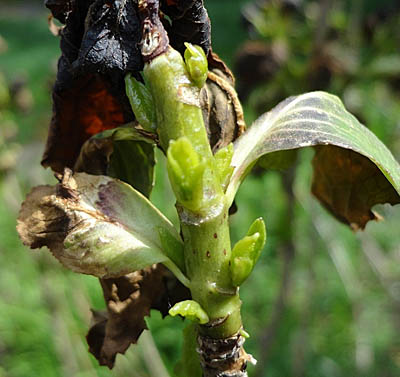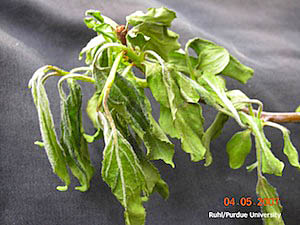Cold Weather and Your Plants
By Elaine Homstad, Fairfax Master Gardener
|
|
|
||||
You may think these are just different names for the same thing — damage to plants due to cold weather — but you would be wrong.
While some of the symptoms may appear to be the same, the long- and short-term damage to your plants is where the difference lies, so I’ll try to sort them out for you.
Chilling injury can best be described as damage to plants caused by rapid changes between the plant’s tolerated high and low temperature limits. These temperatures are the ranges ABOVE freezing (32 F or 0 C). The damage that this type of injury causes most often occurs with tropical or sub-tropical plants grown in the U.S., but can also happen to native plants.

Damage and new growth on Hydrangea
The effect of chilling injury is that the basic processes that allow a plant to grow and develop are interrupted, and the plant is unable to adapt quickly enough to keep all the necessary processes in balance. This results in visible damage (distortion, necrosis, shriveling within veins, spotting or color loss on leaves) or, more insidiously, lack of growth and delayed or diminished flowering and/or fruiting. This is because the basic cell structure has been interfered with and altered. Both above- (stems, foliage) and below-ground (roots) structures can be affected.
As awful as this sounds, it should be noted that this type of damage MOST frequently occurs in greenhouse-grown plants, because the grower is not appropriately monitoring the air and water temperatures to avoid such extremes. For home-gardeners, the biggest problem with this occurs for those who live in temperate or warmer climate zones.

Frost injury on crabapple
Frost injury is also of a shorter duration than freeze injury, so while newly-formed or emerging leaves and buds are most susceptible to this damage, fully-formed leaves are less likely to suffer as much.
Freeze injury occurs during longer, drier periods of freezing and sub-freezing temperatures. Cold air masses displace the warmer air, and rather than just frost on the leaves’ surfaces, the plants lose their warmth, and ice crystals form inside the plant tissues, causing more long-term damage, particularly through desiccation. This type of freeze is called advection.
The signs of all of these types of cold damage can look similar and can be confusing. Or, as mentioned earlier, they are sometimes not evident until months later.
Immediate types include:
- Appearance of being water-soaked and wilted (looks like lettuce that has been placed in hot water)
- Blackened, shriveled leaves and buds
- Dry, browned tips, needle clusters or leaf margins (evergreens)
- Splitting stems or bark on woody plants and shrubs
- Long, narrow and deep vertical cracks in tree trunks
The past six years have brought our Northern Virginia area some extreme weather conditions and exposed us to some new weather terminology — derecho, polar vortex, bombogenesis, thundersnow and Arctic blast.
Whether these weather extremes continue, and their root cause, is not the point. Knowing what to do if and when the need arises is never a bad thing.
Mitigate the chances of chill/frost/freeze damage by:
- Choosing appropriate plants for your landscape. Know both the high and low temperatures the plant can withstand.
- Allowing new plants to “harden off” before cold weather begins. Do not stimulate new growth by improperly fertilizing or pruning in autumn.
- Trying to ensure your plants are healthy and well-watered heading into winter to prevent stress from disease or lack of moisture.
- Being aware of site conditions that could expose your plants to extreme temperature fluctuations, frost pockets or strong winds.
- Mulching plants to provide insulation and prevent soil heaving.
- Providing additional protection (burlap or cloth coverings, tree guards or wraps for young trees, extra mulch or plant covers for roses or small shrubs) when severe weather is predicted.
- Not pruning cold-damaged portions of plants until new growth begins. The only exception to this is damage caused by wind, ice or snow. Make clean cuts with sharp tools to facilitate proper healing of broken branches.
Benjamin Franklin said it best:
“By failing to prepare, you are preparing to fail.”
References
• Managing Winter Injury to Trees and Shrubs, Virginia Cooperative Extension
• Chilling Injury – e-Gro Alert, April 2014
• What is the Difference Between a Frost and a Freeze?, Mark Longstroth, Michigan State
University Extension